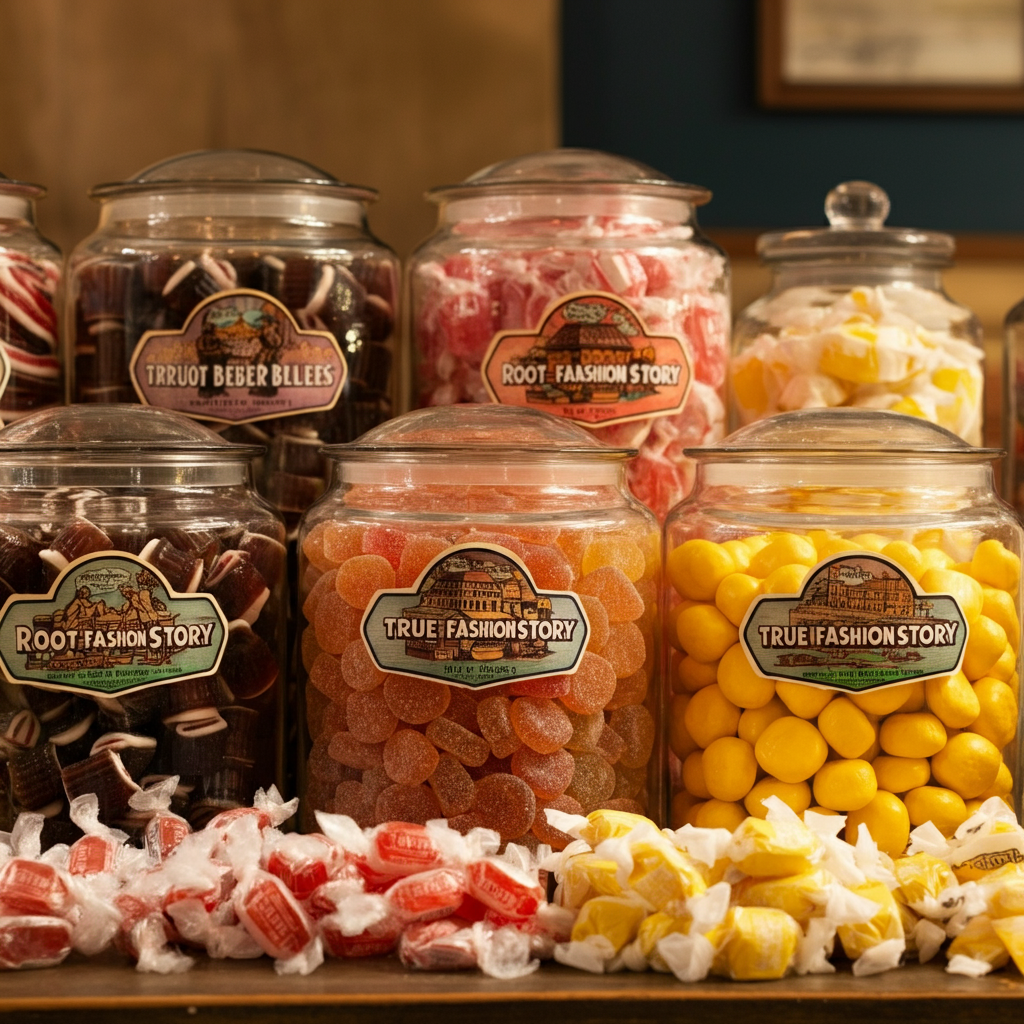Remember walking into a candy store as a kid, your eyes wide with wonder at the rows of colorful jars filled with treats? Many of those sweets are what we now call old fashion candy. These are the confections that have delighted taste buds for generations, from the hard candies your grandparents enjoyed to the chewy treats that filled your pockets. This journey into the world of nostalgic sweets is more than just a sugar rush; it’s a delightful exploration of history, memory, and simple joys. We’ll unwrap the stories behind these timeless treats, discover why they continue to capture our hearts, and explore some of the most beloved candies that have stood the test of time.
Key Takeaways
- Old fashion candy connects us to personal memories and shared cultural history, offering a taste of the past.
- Many classic candies, like Necco Wafers and Bit-O-Honey, have fascinating origin stories dating back to the 19th and early 20th centuries.
- The appeal of these sweets lies in their simple ingredients, unique flavors, and the nostalgic feelings they evoke.
- Regional favorites and penny candies played a significant role in the local candy culture across the United States.
- Finding and enjoying old fashion candy today is easy, thanks to specialty online stores and retro candy shops.
What Makes a Candy “Old Fashion”?
When we talk about old fashion candy, we aren’t referring to a specific flavor or type. Instead, it’s a broad category for sweets that have been around for decades, often predating the mass-produced candy bars that dominate shelves today. These confections are typically characterized by their simple recipes, classic packaging, and a strong sense of nostalgia. Think of candies that were popular in the 1920s, 50s, or even the 70s. They transport us back to a different era, reminding us of childhood moments, family gatherings, or trips to the corner store with a pocketful of change. The charm of these candies is their ability to tell a story, connecting generations through the shared experience of a simple, sweet treat.
The Sweet History of Nostalgic Confections
The story of old fashion candy is deeply woven into the fabric of American history. Many of the sweets we cherish today were born out of innovation and necessity in the late 19th and early 20th centuries. This was a time of great change, and the candy industry was no exception.
The Dawn of an Era: 19th-Century Sweets
The 1800s laid the groundwork for the modern candy industry. Candies like the Necco Wafer, created in 1847, were among the first to be mass-produced using machinery. These simple sugar disks were revolutionary, making candy more accessible and affordable for everyone. Another iconic treat, the circus peanut, also has roots in this period. These unique, banana-flavored marshmallow candies have puzzled and delighted people for over a century, proving that some classics are truly one-of-a-kind.
The Candy Boom of the Early 20th Century
The early 1900s was a golden age for candy creation. The invention of treats like the Tootsie Roll (1907) and the Life Saver (1912) marked a shift towards portable, individually wrapped candies. These innovations made it easier for people to enjoy a sweet treat on the go. The Great Depression also influenced candy making, with companies focusing on affordable sweets that could provide a moment of joy during tough times. Candies like Bit-O-Honey (1924), with its long-lasting chew, offered great value for a nickel.
Iconic Old Fashion Candy You Can Still Buy Today
Many beloved candies from the past are still in production, waiting to be rediscovered by new generations. Their continued popularity is a testament to their timeless appeal. Let’s look at a few enduring classics.
Hard Candies That Have Lasted
Hard candies were some of the earliest forms of confection. They were durable, flavorful, and perfect for savoring.
- Root Beer Barrels: These barrel-shaped hard candies deliver a rich, creamy root beer flavor that has been a favorite for decades. Their distinct shape and taste are instantly recognizable.
- Lemon Drops: A true classic, these tart and sweet candies are often dusted with a fine sugar coating. They provide a refreshing burst of citrus flavor that is simple yet satisfying.
- Butterscotch Disks: Wrapped in crinkly yellow cellophane, these smooth, buttery candies melt slowly in your mouth, releasing a comforting and rich flavor that feels like a warm hug.
Chewy and Taffy Delights
For those who prefer a candy with more bite, old fashion chewy treats and taffies offer a satisfying experience.
- Salt Water Taffy: A staple of seaside towns and boardwalks, salt water taffy comes in a rainbow of colors and an endless variety of flavors. The process of pulling the taffy incorporates air, giving it a light and chewy texture that has been delighting vacationers for over a century.
- Mary Janes: These peanut butter and molasses chews have been around since 1914. Wrapped in their iconic yellow paper with a red stripe, their uniquely rich and nutty flavor is a nostalgic favorite for many.
- Tootsie Rolls: A hybrid between a taffy and a caramel, the Tootsie Roll offers a distinctive cocoa flavor and a signature chew. Its simple, log-like shape has been a lunchbox staple for generations.
Comparing Classic Candies: Taffy vs. Hard Candy
While both fall under the umbrella of old fashion candy, taffy and hard candy offer very different experiences. Understanding their unique qualities can help you find your perfect nostalgic treat.
|
Feature |
Salt Water Taffy |
Hard Candy (e.g., Lemon Drops) |
|---|---|---|
|
Texture |
Soft, light, and chewy |
Hard, smooth, and brittle |
|
Experience |
Enjoyed by chewing |
Enjoyed by dissolving slowly |
|
Ingredients |
Sugar, corn syrup, butter, flavors, salt |
Sugar, corn syrup, water, flavors, citric acid |
|
Best For |
A soft, flavorful bite |
A long-lasting, savoring treat |
|
Variety |
Huge range of flavors and colors |
Typically focused on fruit or spice flavors |
The Regional Charm of Penny Candy
Long before giant bags of candy became the norm, “penny candy” was the treasure of choice for children across America. For just a few cents, you could fill a small paper bag with an assortment of treats. Many of these candies were regional favorites, adding to the local culture of a town or city. In some parts of the country, Squirrel Nut Zippers (a chewy caramel and peanut candy) were the go-to choice, while in others, kids might hunt for Boston Baked Beans (candy-coated peanuts). This tradition of penny candy fostered a sense of discovery and excitement, making a trip to the general store a magical experience. It’s a sweet piece of Americana that reminds us of simpler times.
Why Do We Love Old Fashion Candy So Much?
The appeal of old fashion candy goes far beyond its sugary taste. It taps into a powerful sense of nostalgia, a warm feeling that connects us to our past. For many, a simple piece of candy can unlock a flood of vivid memories—a summer afternoon at grandma’s house, a holiday celebration, or sharing sweets with friends after school. This connection to positive emotions is a major reason why these candies endure. Furthermore, in a world of complex flavors and ingredients, the simplicity of a root beer barrel or a piece of salt water taffy is comforting. As noted in a style piece from truefashionstory.com, trends often circle back, and the appreciation for classic, well-made items is a powerful force in our culture.
Finding Your Favorite Nostalgic Sweets Today
Thankfully, you don’t need a time machine to enjoy the candies of yesteryear. The internet has made it easier than ever to find and purchase old fashion candy. Specialty online retailers offer a vast selection, from decade-specific assortments to individual bulk bags of your favorite treats. Many brick-and-mortar candy shops specializing in retro sweets have also popped up in towns and cities, providing an immersive experience with their vintage decor and shelves lined with glass jars. You can also find a surprising selection in the candy aisle of larger grocery stores or during holidays when nostalgic brands make a special appearance. Whether you’re planning a themed party, creating a unique gift, or simply want to treat yourself, the sweets of the past are just a few clicks or a short drive away.
Conclusion
Old fashion candy is so much more than just a sugary confection. It is a time capsule, a story, and a direct link to the sweet moments of our past. From the simple joy of a penny candy haul to the distinct flavor of a Bit-O-Honey, these treats have woven themselves into our personal and cultural histories. Their enduring appeal lies in their simplicity, their quality, and their power to evoke warm, nostalgic feelings. The next time you unwrap a classic candy, take a moment to savor not just the taste, but the rich history and cherished memories that come with it.
Frequently Asked Questions (FAQ)
1. What is considered the oldest candy?
While boiled sugar treats have existed for centuries, the oldest mass-produced, branded candy still available is arguably the Good & Plenty, which dates back to 1893. Necco Wafers, created in 1847, were around earlier but production has been intermittent in recent years.
2. Why are some old fashion candies hard to find?
Some candies are discontinued due to changing consumer tastes, rising ingredient costs, or corporate acquisitions. Others may only be produced seasonally or have limited distribution, making them regional treasures rather than nationally available treats.
3. What was the most popular candy in the 1950s?
The 1950s saw the popularity of many classics, but Pixy Stix, Atomic Fireballs, and the satellite wafers (flying saucers) were iconic candies that gained immense popularity during this decade. Candy necklaces were also a huge hit among children.
4. Can I buy old fashion candy in bulk?
Yes! Many online candy stores and some specialty shops offer bulk purchasing options for old fashion candy. This is a great choice for parties, events, or for stocking up on a personal favorite that’s hard to find in regular stores.
5. Are the recipes for old fashion candies the same as they were originally?
For many candies, the core recipe remains very similar to the original to preserve the nostalgic flavor profile. However, some recipes may have been slightly altered over the decades due to changes in food regulations, ingredient availability, or manufacturing processes.





